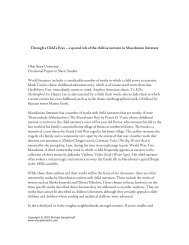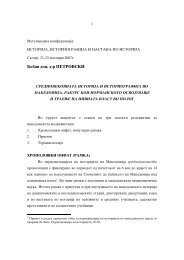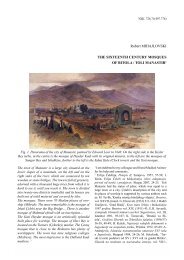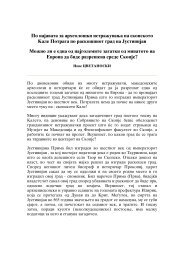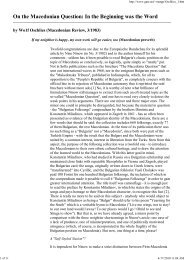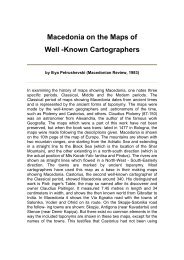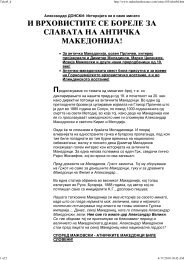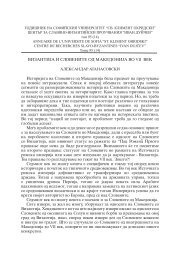Macedonian State-National Concepts and ... - Makedonika
Macedonian State-National Concepts and ... - Makedonika
Macedonian State-National Concepts and ... - Makedonika
Create successful ePaper yourself
Turn your PDF publications into a flip-book with our unique Google optimized e-Paper software.
Russia, <strong>and</strong> came to Macedonia as far as the Pijanec region. But the Adrianople<br />
truce <strong>and</strong> the preliminary San Stefano peace treaty halted the armed offensive of<br />
the <strong>Macedonian</strong> military formations because the liberation of the whole of Macedonia<br />
was envisaged. And when in Berlin Macedonia was once again returned to<br />
Turkey, this resulted in the strongest <strong>and</strong> most important <strong>Macedonian</strong> insurrection<br />
in the 19th century, incorporating the concept of liberation from Ottoman domination,<br />
establishment of a <strong>Macedonian</strong> state, <strong>and</strong> also unification with its neighbours.<br />
Emulating the Austro-Hungarian Act of 1876 <strong>and</strong> relying on the decisions<br />
of the Conference of Constantinople in early 1877, the <strong>Macedonian</strong>s dem<strong>and</strong>ed<br />
“a <strong>Macedonian</strong> kingdom”, based on the concept of a dual monarchy with Bulgaria.<br />
When this attempt, too, failed (due to the strong reactions in both Bulgaria <strong>and</strong><br />
Serbia), the <strong>Macedonian</strong>s founded the significant <strong>Macedonian</strong> League with an<br />
impressive armed force <strong>and</strong> worked out the first Constitution for the <strong>State</strong><br />
Organization of Macedonia (1880). With coordinated efforts a <strong>National</strong> Assembly<br />
of Macedonia was convened in southern Macedonia, headed by comm<strong>and</strong>ers<br />
from the Kresna Uprising, <strong>and</strong> the first Provisional Government of Macedonia<br />
was formed, whose acts were sent <strong>and</strong> made known to European diplomacy <strong>and</strong><br />
the wider public.<br />
From this point onwards an increasing number of proposals were put forward<br />
for a Balkan federation (confederation) with Macedonia as one of its equal<br />
members. Paul Argyriades, a <strong>Macedonian</strong> living in France, worked out the ideas<br />
for such a unification (1885), <strong>and</strong> Leonidas Voulgaris <strong>and</strong> Vasil Simov founded<br />
the Eastern (or Balkan) Confederation Society in Athens (1887). In the Bulgarian<br />
town of Gabrovo, Spiro GulapÌev from Lerin published his book An Essay on the<br />
Ethnography of Macedonia (1887), where he elaborated the idea of a Balkan<br />
federation as the single condition without which there “will be no free Macedonia”.<br />
2.<br />
After the Congress of Berlin (1878) Macedonia remained the only Slavic l<strong>and</strong><br />
entirely within the boundaries of Turkey, but Article 23 of the Treaty left some<br />
hope for the autonomy of the <strong>Macedonian</strong>s. This was the principal stipulation<br />
involving international guarantees for the liberation idea in the ensuing period up<br />
to the Treaty of Bucharest (1913), <strong>and</strong> even after the start of the First World War,<br />
when the aforementioned treaty was proclaimed invalid. Hence the Secret <strong>Macedonian</strong>-Adrianople<br />
Revolutionary Organization (TMORO) invoked Article 23<br />
from the moment of its foundation (1893). A decade later it started the Ilinden<br />
Uprising (1903) by the same token, dem<strong>and</strong>ing, above all, autonomy, <strong>and</strong> elaborating<br />
it in different variations <strong>and</strong> combinations. We must emphasize that during<br />
238



